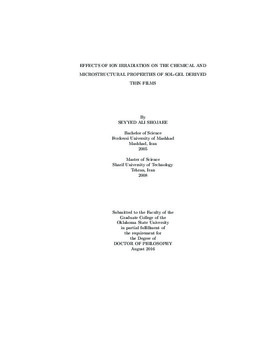| dc.description.abstract | The effects of ion irradiation on the chemical and structural properties of ion irradiated thin films were studied. Ion irradiation was performed using 200 keV H+, 400 keV N2+, 1 MeV Cu+, 4 MeV Cu2+, and 9 MeV Cu3+ ions. The irradiation targets were sol-gel derived silica-based thin films based on TEOS/MTES ingredients coated on a (100) silicon substrate. The structure of the films was studied by a combination of Raman spectroscopy, photoluminescence spectroscopy, Fourier transform infrared (FT-IR) spectroscopy, X-ray diffraction (XRD), elastic recoil detection (ERD), Rutherford backscattering spectrometry (RBS), atomic force microscopy, scanning electron microscopy, and X-ray photoelectron spectroscopy (XPS). The results indicate that irradiation with 200 keV H+ and 400 keV N2+ ions only causes hydrogen loss, whereas irradiation with 1 MeV Cu+, 4 MeV Cu2+, and 9 MeV Cu3+ ions leads to hydrogen, oxygen, and carbon loss. A systematic investigation of the structure of amorphous silica and free carbon clusters formed during ion irradiation was performed. The results indicate that there is a decrease in the Si-O-Si bond angle of the silica phase with increasing ion energy. In addition, evidence of a transformation from tetrahedrally coordinated silica to octahedrally coordinated silica is observed after ion irradiation with 9 MeV Cu3+ ions. It was also found that, compared to heat-treated films, the free carbon clusters formed during ion irradiation have more defective graphitic six-fold structure. After ion irradiation with 4 MeV Cu2+ and 9 MeV Cu3+ ions, the Raman spectroscopy results indicates a complete destruction of the graphitic six-fold structure. It is also confirmed that with increasing irradiation fluence and ion energy, there is an increase in carbon incorporation within the silica structure. The microstructure of the films is determined as an amorphous silica matrix with isolated clusters of amorphous carbon. The structural changes after ion irradiation, specifically, changes in the Si-O-Si bond angle and concentration of carbon-rich tetrahedra were then used to explain the enhancement in the elastic modulus and hardness of the ion irradiated films. The results indicate that the changes in the Si-O-Si bond angle was the dominant mechanism for the enhancement of the elastic modulus of the films after ion irradiation. | |
